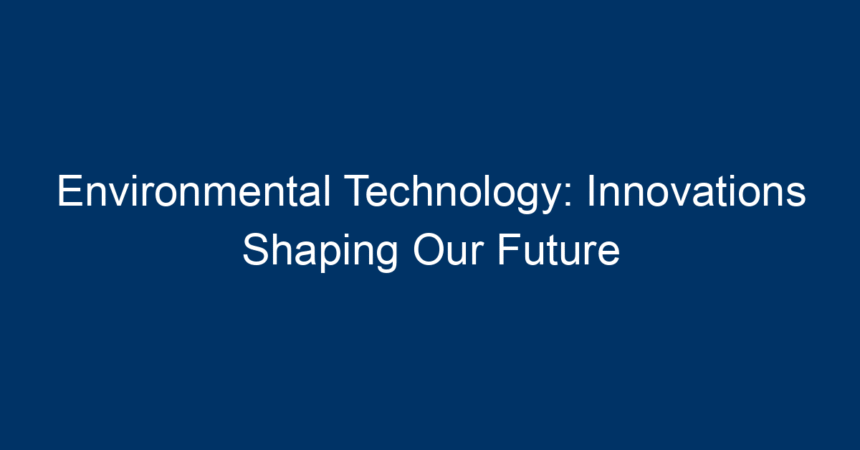As the world grapples with the pressing challenges of climate change, pollution, and resource depletion, the role of environmental technology has never been more crucial. This broad field encompasses innovations that aim to protect the environment and mitigate the impacts of human activities. From renewable energy sources to waste management solutions, environmental technology is not just a buzzword; it’s a pathway to a sustainable future. In this article, we will explore various facets of environmental technology and how these innovations are shaping our lives and the planet.
The Importance of Environmental Technology
Environmental technology can be understood as a collection of tools, systems, and practices designed to monitor, reduce, and manage environmental impacts. Its importance cannot be overstated, given the urgency of the global climate crisis. By harnessing these innovations, we can safeguard our ecosystems, enhance resource efficiency, and promote sustainable development.
A Brief History
The roots of environmental technology can be traced back to early conservation efforts and pollution control measures. However, the modern framework began gaining traction in the late 20th century as awareness of environmental issues grew. Technologies like solar panels, wind turbines, and water purification systems began to emerge, shaping the burgeoning field and setting the stage for future advancements.
Key Innovations in Environmental Technology
1. Renewable Energy Solutions
One of the most significant advancements in environmental technology is the development of renewable energy sources. Solar, wind, hydro, and geothermal energy are critical to reducing our dependence on fossil fuels.
Solar Power: Solar panels have become increasingly efficient and affordable, allowing homes and businesses to harness energy from the sun. With advancements in photovoltaic technology, solar energy is now one of the fastest-growing energy sectors globally.
Wind Energy: Wind turbines have evolved in design and capability. Modern wind farms can generate significant power while minimizing their ecological footprint. Offshore wind farms, in particular, hold the potential for massive energy generation without occupying valuable land.
Hydroelectric Power: Utilizing the flow of water to produce electricity, hydroelectric power is a reliable renewable energy source. Innovations in turbine technology and mini-hydroelectric systems are making this energy source more accessible and less disruptive to ecosystems.
2. Waste Management Technologies
Effective waste management is essential for reducing landfills and minimizing pollution. Innovations in this area include:
Recycling Technologies: Advances in sorting and processing technologies allow for more efficient recycling processes. Innovations like AI-assisted sorting systems help identify and separate recyclables from waste streams, increasing recycling rates and reducing contamination.
Composting Solutions: Composting technologies convert organic waste into nutrient-rich soil, contributing to a circular economy. Innovations like smart compost bins streamline the composting process, making it accessible to households and businesses alike.
Waste-to-Energy Technologies: Turning waste into energy through incineration or gasification can reduce landfill use while generating electricity. Modern waste-to-energy plants employ emission-reducing technologies to minimize their impact on air quality.
3. Water Purification and Management
Access to clean water is a fundamental human right, yet billions of people still lack it. Environmental technology is addressing this challenge through innovative solutions:
Desalination: Technologies that turn seawater into potable water are increasingly important in arid regions. Membrane distillation and reverse osmosis technologies are making desalination more energy-efficient.
Water Filtration Systems: Advanced filtration technologies, including bio-sand filters and ultraviolet purifiers, are providing communities around the world with safe drinking water. These innovations are essential for reducing waterborne diseases.
Smart Water Management: Digital technologies are transforming how we manage and distribute water resources. IoT devices can monitor water quality and consumption, helping utilities manage their systems more effectively and sustainably.
4. Sustainable Agriculture Technologies
The agricultural sector is a significant contributor to environmental degradation. Environmental technology is helping to create more sustainable farming practices:
Precision Agriculture: Using drones and sensors, precision agriculture allows farmers to monitor crop health, soil conditions, and resource use. This data-driven approach increases yields while reducing waste.
Biotechnology: Genetic engineering is facilitating the development of crops that require less water and are resistant to pests. These innovations can reduce the environmental impact of agriculture and enhance food security.
Vertical Farming: This innovative farming approach allows for the cultivation of crops in stacked layers, optimizing space and resources. Utilizing hydroponics or aeroponics, vertical farming reduces water usage and can be implemented in urban settings, minimizing transportation emissions.
Challenges Facing Environmental Technology
While the potential of environmental technology is immense, challenges remain. Funding, regulatory hurdles, and public awareness are significant barriers to the widespread adoption of these innovations.
The Need for Policies and Regulations
Governments play a pivotal role in fostering a conducive environment for environmental technology. Incentives for research and development, along with frameworks that support the implementation of sustainable practices, are critical for advancing this field.
Public Awareness and Education
Raising awareness about the benefits and availability of environmental technologies is essential. Educational campaigns can help individuals and businesses understand their options and inspire them to adopt more sustainable practices.
Actionable Insights
As we embrace the future shaped by environmental technology, individuals and organizations can take several actionable steps:
-
Invest in Renewable Energy: Explore solar panels, wind turbines, or green energy subscription services to reduce your carbon footprint.
-
Adopt Sustainable Practices: Implement methods like composting or recycling at home and in the workplace.
-
Support Local Water Conservation Efforts: Advocate for and participate in community projects that promote clean water access and management.
-
Stay Informed: Educate yourself about innovations in agricultural technology and consider supporting local sustainable farms.
- Advocate for Policy Changes: Engage with local policymakers to promote regulations that support environmental technology initiatives.
Conclusion
Environmental technology stands at the forefront of our fight against climate change and environmental degradation. From renewable energy solutions to waste management and sustainable agriculture, the innovations in this field offer promising pathways for building a sustainable future. By understanding and supporting these technologies, we can collectively work toward a healthier planet.
As we look ahead, the challenge will be to implement these technologies on a global scale, ensuring that everyone can benefit from a cleaner, safer environment. Together, we can innovate, educate, and drive change towards a sustainable and eco-friendly future.




